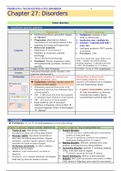PROBLEM 4. NEUROGENERATIVE DISORDER 1
Chapter 27: Disorders
Motor disorders
A. Hyperkinetic (dystonic syndrome)
Huntington’s Tourette’s syndrome
Intellectual problems, personality changes 1. Multiple tics (twitches of face,
& “choreas” limbs or whole-body)
Progression: abnormal/involuntary 2. Inarticulate cries + multiple tics
movements are rare and not intense in the 3. Echolalia + Coprolalia (shit-talk) +
beginning but strong and frequent later cries + tics
Behavioral symptoms: Intelligent, productive NOT neurotic
Symptoms o Impairment of recent memory or psychotic
o Disability to manipulate acquired Prevalence: 1/360
knowledge
o Slowed information processing Tics of eye, head, face, upper limbs, lower
Emotional: Anxiety, depression, mania, limbs > complex movements (hitting,
schizophrenia-like psychoses, suicide (is touching, jumping) > Coprolalia (develops
possible) in 60%, but disappears in 1/3 of them)
Age of onset Usually 30-50, white Europeans 2-15 (M = 7), by 11 97% symptomatic
Autosomal dominant genetic disorder, CAG -
Genetics
repetition chromosome 4
Mechanisms Basal ganglia (atrophied & neuronal loss) Abnormalities in dorsal stream
Shrinkage and thinner cortex Basal ganglia dopamine system,
Explanation: imbalance among various NT excessive cell number (lower symptoms
systems in basal ganglia with anti-dopaminergic drugs)
Glutamate projection from cortex to bg
Dopamine projection from substantia nigra Cognitive abnormalities: mainly of
to basal ganglia the right hemisphere e.g. drawing,
DIE - GABA projection from basal ganglia remembering complex figures,
to substantia nigra (initiation of movement) remembering locations in daily life.
DIE - ACh neurons in basal ganglia
Dead GABA & Ach decreased
inhibition of dopamine cell by GABA
increased dopamine release in basal ganglia
“choreas”
B. Hypokinetic
Parkinson’s: 0.1 to 1% of world population, w/ rise in the old age
Positive symptoms: acquire normally inhibited beh Negative symptoms: loss of normal behaviors
1. Tremor at rest: stops during voluntary 1. Postural disorders
movement or sleep, pill-rolling hand tremors o Disorder of fixation: inability/difficulty to hold normal
2. Muscular rigidity: movement resisted but w/ position of certain body parts
force they can still do short distance again o Disorder of equilibrium: problems with standing or
resistance, cogwheel rigidity (passive flexion or maintaining standing position w/o support
extension of a joint in series of steps) 2. Righting disorders: difficulty standing from lying
3. Involuntary movements: to relieve stiffness, position, in advanced cases rolling problems
tremor or for no reason 3. Locomotive disorders: problem w/ initiating stepping,
o Akathisia (cruel restlessness): co-occur w/ if they walk short steps & support
inactivity o Festination: increasing fast steps running
o Oculogyric crisis: posture distortion, involuntary 4. Speech disturbance: absence of tone (prosody)
head and eye turns for minutes or hours 5. Akinesia: slow, poor movement (even in face or blinks,
walk, speech or fidgeting), poor repetitive movements,
, PROBLEM 4. NEUROGENERATIVE DISORDER 2
in extreme form still for hours
Genetics Not inherited - relativity component (25 % of pts have a relative), more gen. variants greater risk
Gradual start of pos and neg symptoms w/ tremor in one hand and stiffness in distal parts,
movements slow, eye-blinking and poverty of expression, motionless, speech slows, difficulty
Progression w/ swallowing
o Rare fast progression, usually 10-20 years
o On-off quality: remission in activating situations (emergency)
o Idiopathic: unknown
o Post-encephalitic: encephalitic lethargica
Causes
o Drug-induced: tranquilizers (usually reversible), heroin
o Neurotransmitter: Dopamine and norepinephrine low degeneration of basal ganglia cells
o Counselling on symptoms
o Physical therapy e.g. massage and heat
Treatment: o Drug therapy: i) increase dopamine activity, ii) suppress other structures heightened
symptoms and activity (L-dopa, MAOI, TCAs)
support no o Transplant of dopaminergic cells
treatment o DBS + drugs most effective
Psychological aspect: decrease of cognitive function, low mood, lack of motivation
Similar to frontal lobe basal ganglia symptoms (parallels Alzheimer’s)
Dementias
Acquired and persistent syndrome of intellectual impairment (> 65
years)
The most prevalent is Alzheimer’s (65% of dementias)
1. Major Neurocognitive disorder (NCD)
Substantial cognitive decline from the previous level of
performance, decline in test performance
Marked impairment in daily life
2. Mild Neurocognitive disorder (mild NCD)
Similar definition w/o the marked impairment in functioning
Brain correlates of Alzheimer’s
1. Neuritic (amyloid) plaques: increase of plaques (tau protein)
2. Paired Helical Filaments/ neurofibrillary tangles: in cortex and hippocampus (mainly posterior) tau-related &
present in other disorders (e.g. other dementias, Parkinson’s and Down Syndrome)
3. Neocortical changes: mainly posterior parietal, inferior temporal and limbic cortices
1/3 of the volume is lost after progression of AD
4. Paralimbic cortex changes: entorhinal cortex most severely and earliest impaired region assoc. w/ memory
explains early memory loss
5. Cell changes: loss/atrophy of large neurons, hippocampus neuronal damage of AD = healthy person > 80 years old
6. NT changes: Ach, noradrenaline, dopamine, serotonin, and glutamate receptors (AD: reduction in 2 or more)
Cause
Genes: increased risk w/ relative AD mainly if sibling or even higher AD parent 3 genes
1. B-APP (on chromosome 21) amyloid plaques & neurofibrillary tangles
2. Tau protein
3. Prensenilin proteins
Trace metals: x10-30 more Alu
Immune reactions: anti-brain antibodies degeneration
Blood flow: poor blood circulation and glucose metabolism (causal or secondary??)




